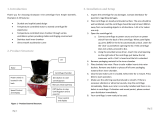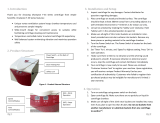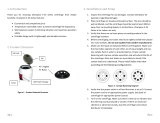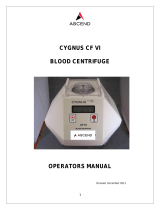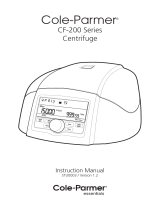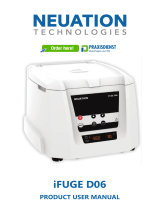Page is loading ...

Version 06/2007, Rev. 1.15.1 of 05/10/2011 - sb
Translation of the original operating manual
Operating Manual
Centrifuge
3-16P
Please retain for later use!


Version 06/2007, Rev. 1.15 of 16/09/2011 - sb page 3 of 75
Translation of the original operating manual
In case of inquiries please state the following number:
Serial number:
Copyright by
Sigma Laborzentrifugen GmbH
An der Unteren Söse 50
37520 Osterode am Harz
Germany
Phone +49 (0) 55 22 / 50 07-0
Fax +49 (0) 55 22 / 50 07-12
E-mail: info@sigma-zentrifugen.de
For service
please use our
service request
form on our website:
www.sigma-zentrifugen.de → [Service Area]
or contact:
Phone +49 (0) 55 22 / 50 07-84 25
Fax +49 (0) 55 22 / 50 07-94 25
E-mail: service@sigma-zentrifugen.de




Version 06/2007, Rev. 1.15 of 16/09/2011 - sb page 7 of 75
Translation of the original operating manual
Table of Contents
1
General Information 11
1.1
Importance of the Operating Manual 11
1.2
Intended Use 11
1.3
Technical Data 12
1.3.1
Ambient Temperature 12
1.4
Scope of Supply 13
1.5
Standards and Regulations 13
2
Safety Instructions and Hazard Warnings 14
2.1
Symbols used in the Safety Instructions 14
2.2
Symbols used in the Operating Manual 15
2.3
Informal Notes on Safety 15
2.4
Safety Instructions for Centrifugation 16
2.4.1
Special Instructions 17
2.4.2
Resistance of Plastics 18
2.5
Prohibited Centrifuging Operations and Hazard Warnings 18
2.5.1
Special Hazards 19
2.6
Checks by the Operator 20
2.7
Instructions for Emergency Situations 20
2.8
Remaining Hazards 20
3
Transport and Storage 21
3.1
Dimensions and Weight 21
3.2
Notes on Transport 21
3.3
Notes on Storage 21
4
Set-up and Connection 22
4.1
Unpacking the Centrifuge 22
4.1.1
Transport Safety Device 22
4.2
Installation 23
4.2.1
Installation Site 23
4.2.2
Connection 23
4.2.3
Fuses 23

Version 06/2007, Rev. 1.15 of 16/09/2011 - sb page 8 of 75
Translation of the original operating manual
5
Using the Centrifuge 24
5.1
Description 24
5.1.1
Operating Elements 24
5.1.1.1
Operating Panel 25
5.1.1.2
Name Plate 25
5.1.2
Construction and Constructive Safety Measures 26
5.1.3
Drive 26
5.1.4
Operation and Display 26
5.1.5
Electronic System 26
5.1.6
Safety Devices 27
5.1.6.1
Lid Lock and Lid Closing Device 27
5.1.6.2
Standstill Monitoring 27
5.1.6.3
System Check 27
5.1.6.4
Ground Wire Check 27
5.1.6.5
Imbalance Monitoring System 27
5.2
Initial Start-Up 28
5.2.1
Switching the Centrifuge ON 28
5.2.2
Opening and Closing the Lid 28
5.2.3
Installation of Rotors 29
5.2.3.1
Installation of Angle Rotors with a Hermetically Sealed Lid30
5.2.4
Installation of Accessories 31
5.2.4.1
Carrier Systems 32
5.2.4.2
Tubes 32
5.2.5
Service Life of Rotors and Accessories 32
5.2.6
Starting the Centrifuge 33
5.2.7
Interrupting a Centrifugation Run 33
5.2.7.1
Interrupting a Deceleration Process 33
5.2.7.2
Softstart and Softstop Function 34
5.3
Display / Program Options 34
5.3.1
Time 35
5.3.1.1
Changing the Time Increments 35
5.3.1.2
Short Run 36
5.3.1.3
Continuous Run 36
5.3.2
Speed 37
5.3.2.1
Changing the Speed Increments 37
5.3.3
Relative Centrifugal Force (RCF) 38
5.3.3.1
Changing the RCF Increments 38

Version 06/2007, Rev. 1.15 of 16/09/2011 - sb page 9 of 75
Translation of the original operating manual
5.3.4
Rotor Preselection 39
5.3.5
Program 40
5.3.5.1
Saving the Current Settings 40
5.3.5.2
Calling Up Stored Programs 40
5.3.6
Lockdown 41
5.3.6.1
Permanent Lockdown 41
5.3.7
Activating/Deactivating the Automatic Lid Opening Function 41
5.3.8
Activating/Deactivating the Sound Signal 42
6
Malfunctions and Error Correction 43
6.1
Error Mode 43
6.2
Error Correction 43
6.2.1
No Indication on the Display 43
6.2.2
Centrifuge cannot be started 43
6.2.3
Centrifuge decelerates during Operation 43
6.2.4
Lid cannot be opened 44
6.2.5
Emergency Lid Release 44
6.2.6
Error Codes 45
6.2.7
Service Contact 46
7
Care and Maintenance 47
7.1
Cleaning and Care 47
7.1.1
Centrifuge 47
7.1.2
Accessories 48
7.1.2.1
Plastic Accessories 48
7.1.2.2
Aluminum Accessories 48
7.1.3
Rotor, Buckets, and Multiple Carriers 49
7.1.4
Load-bearing bolts 49
7.1.5
Glass Breakage 50
7.2
Sterilization and Disinfection of the Rotor Chamber and Accessories 50
7.2.1
Autoclaving 51
7.3
Service 52
7.4
Return of defective parts 53
8
Disposal 54
8.1
Disposal of the Centrifuge 54
8.2
Disposal of the Packaging 54

Version 06/2007, Rev. 1.15 of 16/09/2011 - sb page 10 of 75
Translation of the original operating manual
9
Warranty and Liability 54
10
Suitable Accessories 55
10.1
Maximum speed for tubes 65
10.2
Graphical Representation of the Rotors 66
11
Appendix 67
11.1
Formulae – Mathematical Relations 67
11.1.1
Relative Centrifugal Force (RCF) 67
11.1.2
Density 67
11.1.3
Speed-Gravitational-Field-Diagram 67
11.2
Table of rotors and accessories with a different service life 69
11.3
Resistance Data 70
12
Index 73

Version 06/2007, Rev. 1.15 of 16/09/2011 - sb page 11 of 75
Translation of the original operating manual
1 General Information
1.1 Importance of the Operating Manual
• A fundamental requirement for the safe and trouble-free operation of the
centrifuge is to be familiar with the fundamental safety instructions and all
possible hazards.
• The operating manual includes important information concerning the safe
operation of the centrifuge.
• This operating manual and in particular the notes on safety and hazards must
be observed by all persons operating the centrifuge.
• In addition, the local rules and regulations for the prevention of accidents
must be complied with.
1.2 Intended Use
Centrifuges are power-driven machines that separate liquids from solid matter,
liquid mixtures, or solid mixtures by centrifugal force (see BGR 500, chapter 2.11,
part 3). They are solely intended for this purpose. Any other use beyond this area
of application is regarded as improper use. SIGMA Laborzentrifugen GmbH
cannot be held liable for any damage resulting from such improper use.
The intended use also includes
• observation of all the notes and instructions included in the operating manual
and
• compliance with the care, cleaning, and maintenance instructions.

Version 06/2007, Rev. 1.15 of 16/09/2011 - sb page 12 of 75
Translation of the original operating manual
1.3 Technical Data
Manufacturer: S I G M A Laborzentrifugen GmbH
An der Unteren Söse 50
37520 Osterode
Type: 3-16P
Electr. connection:
Protection class:
IP code:
See name plate
I
20
Connected load (kVA):
Power consumption (kW):
Max. current consumption (A):
0.82
0.5
3.2 (at 220-240 V / 50-60 Hz)
6.8 (at 120 V / 60 Hz)
Performance data:
Max. speed (rpm):
Max. capacity (ml):
Max. gravitational field (x g):
Max. kin. energy (Nm):
14 500
1 000
21 475
9 530
Other parameters:
Time range:
Storage locations:
10 sec – 11 h 59 min;
short run, continuous run
50
Physical data:
Depth (mm):
Width (mm):
Height (mm):
Weight (kg):
EMC as per EN 61326:
Noise level (dBA):
600
460
355
48
Klasse B
< 70
1.3.1 Ambient Temperature
The figures are valid for an ambient temperature of +23°C ± 2 °C and a
nominal voltage ± 10 %
∗
.
Allowable ambient temperature +5°C to +40°C.
Max. relative humidity of air 80% up to 31°C with a linear decrease to
50% relative humidity of air at 40°C.
Lowest storage and transport temperature –20°C (see chapter 3
"Transport and Storage", page 21).
∗
At a nominal voltage of 100V or 200V, a tolerance of +10% / -5% applies.
Fig. 1.1: Technical Data

Version 06/2007, Rev. 1.15 of 16/09/2011 - sb page 13 of 75
Translation of the original operating manual
1.4 Scope of Supply
The centrifuge comprises:
• 1 connecting cable depending on the voltage variant
• 1 rotor wrench Part no. 930 100
• 20 ml slushing oil Part no. 70 104
• 1 tube of grease for load-bearing bolts Part no. 70 284
Documentation:
• Operating manual incl. EU Declaration of Conformity (page 5)
Accessories
according to your order, our order confirmation, and our delivery note.
1.5 Standards and Regulations
Please refer to the enclosed EU Declaration of Conformity (page 5).

Version 06/2007, Rev. 1.15 of 16/09/2011 - sb page 14 of 75
Translation of the original operating manual
2 Safety Instructions and Hazard Warnings
2.1 Symbols used in the Safety Instructions
International symbols used for SIGMA centrifuges:
Symbol Title
Gefährliche elektrische Spannung
Dangerous voltage
Courant haute tension
Achtung, Bedienungsanleitung lesen
Attention, consult instruction manual
Attention, consulter mode d'emploi
Ein (Netzverbindung)
On (Power)
Marche (mise sous tension)
Aus (Netzverbindung)
Off (Power)
Arrêt (mise hors tension)
Schutzleiteranschluss
Protective earth (ground)
Liaison à la terre
Erde
Earth (ground)
Terre
Netzstecker ziehen
Unplug mains plug
Tirer la fiche de prise
Vorsicht Quetschgefahr
Caution! Risk of bruising
Attention! Danger de blessure
Drehrichtungspfeil
Arrow direction of rotation
Flèche sens de rotation
Heiße Oberfläche
Hot surface
Surface chaude
Nicht mit dem Hausmüll entsorgen
Do not dispose as part of domestic waste
Ne pas jeter avec les déchets ménager
Fig. 2.1: Symbols used for SIGMA centrifuges
I
O

Version 06/2007, Rev. 1.15 of 16/09/2011 - sb page 15 of 75
Translation of the original operating manual
2.2 Symbols used in the Operating Manual
Symbols used in the Operating Manual:
Symbol Title
Gefährliche elektrische Spannung
Dangerous voltage
Courant haute tension
Achtung, mögliche gefährliche Situation
Attention, potentially dangerous situation
Attention, situation potentiellement dangereuse
Attention!
Hinweis auf wichtige Sachverhalte
Note concerning important facts
Information très importante
Fig. 2.2: Symbols used in the Operating Manual
2.3 Informal Notes on Safety
The operating manual is an integral part of the product.
• Please retain the operating manual throughout the service life of the
centrifuge.
• Please hand the operating manual over to any subsequent owner or user of
the centrifuge.
• Please add any amendments that you receive to the manual.
• Please make the operating manual readily available at the exact location of
the centrifuge at all times.
• The operating personnel must have read and understood the operating
manual prior to operation.
• Please also comply with the general and company-specific rules and
regulations for the prevention of accidents.

Version 06/2007, Rev. 1.15 of 16/09/2011 - sb page 16 of 75
Translation of the original operating manual
2.4 Safety Instructions for Centrifugation
• Ensure that the centrifuge was set up properly (see section 4.2 “Installation”,
page 23).
• Check the centrifuge, rotor, and accessories for external signs of damage
prior to start-up.
• Do not use the centrifuge with rotors and accessories that have not been
approved by the manufacturer. In case of doubt, contact our service team
(See 6.2.7 "Service Contact", page 46).
• Ensure that rotor and buckets are correctly fitted (see 5.2.3 "Installation of
Rotors“, page 29 and Fig. 2.3).
• Please observe the instructions on the installation of accessories (see 5.2.4,
page 31).
• The load of the rotor as defined by the manufacturer and the maximum speed
must not be exceeded (see the engraving on the rotor or bucket).
• The rotor must be loaded symmetrically at equal weights.
Fig. 2.3: Fitting of the buckets
1
2
1 Bucket installed correctly
2 Inadmissible operating state

Version 06/2007, Rev. 1.15 of 16/09/2011 - sb page 17 of 75
Translation of the original operating manual
2.4.1 Special Instructions
• If liquids with a density
>
1.2 g/cm
3
are used, reduce the speed (see 11.1.2
"Density", page 67).
• Protective clothing is not required for the operation of the centrifuge.
The materials to be centrifuged may, however, require special safety
measures (e.g. centrifugation of infectious, toxic, radioactive, or pathogenic
substances).
• Spin infectious material in sealed rotors and buckets only in order to prevent
the material from leaking into the centrifuge.
• Avoid the corrosion of the centrifuge and its accessories by careful
maintenance (see chapter 7 "Care and Maintenance", page 47 ff).
• When not using the centrifuge, open the lid so that all liquids can evaporate.
• Stop the centrifuge immediately in the event of a malfunction. Eliminate the
problem (see 6.2, page 43 ff) or inform the SIGMA Laborzentrifugen GmbH
service team (see 6.2.7 "Service Contact", page 46).

Version 06/2007, Rev. 1.15 of 16/09/2011 - sb page 18 of 75
Translation of the original operating manual
2.4.2 Resistance of Plastics
Chemical influences have a strong effect on the polymeric chains of plastics, and
therefore, on their physical properties. Plastic parts can be damaged if solvents,
acids, or alkaline solutions are used.
• Please refer to the resistance table (see 11.2, page 69)!
2.5 Prohibited Centrifuging Operations and Hazard Warnings
Under the rules stipulated by the German trade association BGR 500, chapter
2.11, part 3, the operator is obliged to:
• take measures in order to prevent all danger to life or health during work.
• ensure that centrifuges are operated properly and entirely as intended (see
chapter 1.2 "Intended Use", page 11 of this Instruction Manual).
• take measures for the safe opening of centrifuges.
Please comply with the following hazard warnings. In the case of non-
compliance with the instructions, the manufacturer cannot be held liable or
subject to any warranty claims.
• Only persons who have read and understood the operating manual in whole
are authorized to operate the centrifuge (see 2.3 "Informal Notes on Safety",
page 15).
• Keep informed about local fire prevention regulations and measures to
contain harmful emissions (depending on the substances to be centrifuged).
• Do not use the centrifuge if it was installed incorrectly.
• Do not use the centrifuge without panels.
• Do not hit or move the centrifuge during its operation.
• Do not lean against or rest on the centrifuge during its operation.
• Maintain a safety distance of at least 30 cm around the centrifuge.
• Do not store any dangerous goods in the centrifuge area.
• Only use the centrifuge with rotors and accessories that have been approved
by the manufacturer. We explicitly warn against the use of equipment of poor
quality. Breaking glass or bursting vessels can cause dangerous imbalances
at high speeds.

Version 06/2007, Rev. 1.15 of 16/09/2011 - sb page 19 of 75
Translation of the original operating manual
• Do not spin any substances that could damage the material of the rotors and
buckets of the centrifuge in any way. Highly corrosive substances, for
example, damage the material and affect the mechanical strength of the
rotors and buckets.
• Infectious, toxic, pathogenic, and radioactive substances must be centrifuged
in certified rotors and vessels. Take suitable precautions for your own
safety if there is a risk of toxic, radioactive, or pathogenic
contamination.
• Please comply with the special precautions for taking care of the
centrifuges and accessories. These are measures for maintaining
operational safety! (see chapter 7 "Care and Maintenance", page 47)
• Defective lid relieving devices could cause the centrifuge lid to fall (contact
Service, if necessary). Risk of crushing!
Attention!
• Ensure that all repairs are performed only by authorized and specialized
personnel (see 6.2.7 "Service Contact", page 46).
2.5.1 Special Hazards
• Do not open the lid when the rotor is in motion!
• Do not reach into the rotor chamber when the rotor is in motion!
• Do not hold your fingers between the lid and the housing when closing the lid.
Risk of crushing!
• Do not use the centrifuge if the rotor is overloaded. (see 2.4 " Safety
Instructions for Centrifugation", page 16).
• Do not use the centrifuge if the rotors and inserts show signs of corrosion or
other defects.
• Do not use the centrifuge if the rotor is loaded asymmetrically.
• Do not use the centrifuge with tubes that are excessively long.
• Do not use the centrifuge with an incompletely loaded drum rotor, swing-out
rotor or angle rotor with interchangeable buckets.
• Do not use the centrifuge within hazardous locations.
• Do not spin explosive or inflammable substances.
• Materials that chemically react with each other with a high level of energy are
prohibited.

Version 06/2007, Rev. 1.15 of 16/09/2011 - sb page 20 of 75
Translation of the original operating manual
2.6 Checks by the Operator
Check all of the safety-relevant parts of the centrifuge at least once per month for
any visible signs of damage (e.g. cracks, corrosion). This applies particularly to
the following:
• Concentricity of the motor shaft:
− Visual inspection: Slowly rotate the rotor by hand without the rotor tie-
down screw. If the motor shaft does not turn around on a perpendicular
axis, the motor and motor shaft must be replaced.
− Refit the rotor correctly after visual inspection (see 5.2.3 "Installation of
Rotors", page 29).
− Auditory inspection: Check the unit for atypical running noises.
• Rubber parts:
− Special attention must be paid to all of the rubber parts (e.g. motor cover,
lid seal, adapter) in terms of visible structural changes. Defective parts
must be replaced immediately.
• Fastening of the trunnion pins in the rotor
• Screw connections
• Rotors and accessories. (see 5.2.5 "Service Life of Rotors an Accessories",
page 32).
2.7 Instructions for Emergency Situations
• If an emergency arises, switch off the centrifuge immediately!
• If in doubt, call the emergency doctor!
Fire-fighting measures or measures for the containment of harmful emissions
depend on the local conditions and on the substances processed in the
centrifuge. Please be informed about the rules and regulations that are applicable
on-site.
2.8 Remaining Hazards
The centrifuge was built state-of-the-art and according to the accepted safety
rules. Danger to life and limb of the user or of third parties, or impairments of the
unit or other material assets cannot be completely excluded when the centrifuge
is used.
• Use the centrifuge only for the purpose that it was originally intended for (see
1.2, page 11).
• Use the centrifuge only if it is in a perfect running state.
• Immediately eliminate any problems that can affect safety.
/
